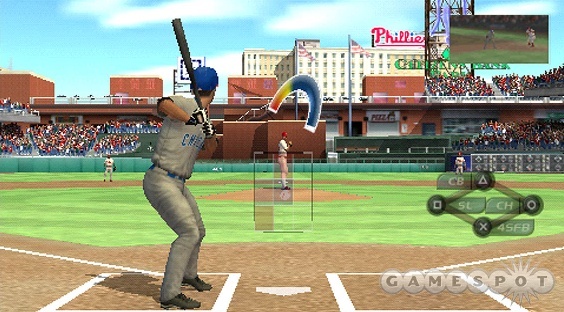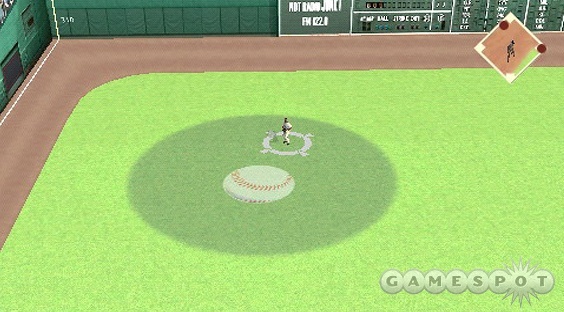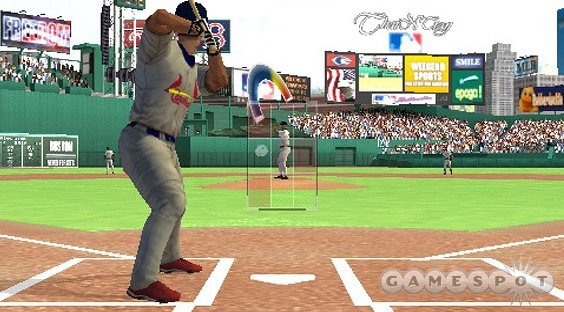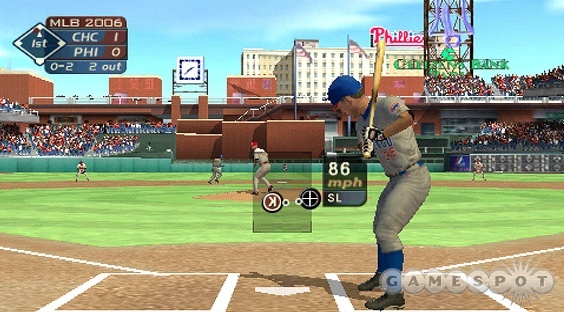MLB for the PSP is basically the PlayStation 2 version of MLB 2006 with a handful of features and niceties taken out. Some people will complain, and rightly so, that the PSP game doesn't have a real franchise mode or offer a way to update rosters...and that it's missing many of the sweet graphical touches the PS2 version has. 989 Studios certainly trimmed away a lot of the fat to cram the PS2 version onto the PSP. But that's the key thing to keep in mind, though: 989 took away the fat but left the meat. The PSP game mostly has the same great gameplay, gorgeous graphics, and sublime commentary the PS2 iteration has. Best of all, it's portable, so you can play it anywhere.

The game menu offers three modes: quickplay, season, and online. The lack of a franchise mode is a shame, but the season mode does at least offer a fair amount of depth. You can set multiple lineups and pitching rotations, swap players between the active and inactive rosters, manage injuries, sign free agents, and set up trades with the CPU. The game keeps track of stats in roughly 80 categories, and it constantly updates them to show you which players are in the running for awards at the end of the season. Unfortunately, apart from the ability to use your own team's players as trade bait in the season mode, there's no way to create custom players, edit player names, or make wholesale roster changes throughout the league.
Online supports both ad hoc (local) and infrastructure (Internet) connections, but the feature set is extremely limited. Unlike the PS2 version, which offers tournaments and downloadable roster updates, the PSP game only offers exhibition play. The server also doesn't keep track of stats or disconnections, which means it's impossible to tell beforehand whether a player has a habit of quitting out of games. It only takes a couple of button presses to sign in to the Internet server and then join a lobby. However, actually getting into a contest is another matter entirely. Quite often, when you accept a challenge, the game will stall out at the acceptance screen or knock you back out to the lobby after an inning or two. Every fifth try or so, you'll get into a game and make it through to the end. The lag isn't too bad during games, at least, and 989 Studios will probably sort out the disconnection problems once more people have the game and take it online.
Load times are reasonable. It takes approximately 30 seconds for the main menu to appear after you first insert the universal media disc. Starting a game takes another 30 seconds of loading, and jumping back out to the menu can take upward of 20 seconds. There isn't any loading between innings, however, so these load times are perfectly acceptable when you consider that a typical nine-inning content can last 20 minutes.
Once you get into a game, you'll immediately be impressed by how crisp and detailed the graphics are. Player bodies and faces are accurate, as are their batting stances and pitching deliveries. Player animation is extremely smooth, and there are enough different animations to ensure you won't see the same play happen over and over again. Diving catches, bare-handed grabs, and offline throws are in there, along with a few flashier plays (such as when the second baseman makes a catch from his knees and then scoops the ball to the shortstop covering second). Throughout the game, the players' uniforms accumulate dirt and grass stains based on what they've done on the field. All 30 MLB stadiums are included. Many of the billboards and advertisements are animated in some way, and the scoreboards actually update to reflect the current box score. Fans of the picture-in-picture base-runner windows from the PS2 game will be happy to know they're in the PSP version as well.
Admittedly, the PSP game is missing many of the sweet graphical touches the PS2 game has, such as TV-style instant replays, batter walk-up rituals, home-run celebrations, and player portraits in stat boxes. MLB for the PSP pretty much sticks to two camera perspectives: the behind-the-plate view that's used for hitting and pitching and the overhead view that's used for fielding. The complete removal of those sexier touches is a crying shame, but their loss is easy to forgive in light of the gorgeous stadiums and wonderfully fluid player animations. You also notice that some numbers, particularly in the pitch-history display, are almost too tiny to see, and certain stadium features, such as foul lines and wall outlines, shimmer and distort during the overhead view. These problems are a result of the developer taking the graphics from the PS2 game and not retouching or optimizing them for the PSP. They're merely minor distractions in the grand scheme of things, but they're worth keeping in mind if your eyesight isn't all that good.

Perhaps the biggest surprise is that MLB, unlike other sports games currently available for the PSP, has a full running commentary. This one pairs San Diego Padres play-by-play announcer Matt Vasgersian with longtime ESPN analyst Dave Campbell. Vasgersian has the general play-calling duties. His vocabulary is rich, and the natural cadence in his voice makes him a real joy to listen to. Campbell's contributions are limited mainly to pointing out a player's specific strengths or weaknesses, along with a snide comment here and there. The PSP game's commentary isn't quite as elaborate as the PS2 game's is, since all the lengthier conversations and fluff stories that Vasgersian and Campbell used to share were removed from the PSP version, but it's still diverse enough to get the job done. Apart from the commentary, the audio also contains a good sampling of traditional ballpark atmosphere. The various sounds for things such as the bat hitting the ball, the ball landing in fielders' gloves, and players sliding in the dirt are right on the money. You'll also hear umpire calls, crowd reactions, and stadium announcements from time to time.
For the most part, MLB provides a reasonable portrayal of what happens during an actual baseball game. The percentages of pop flies, ground balls, errors, and double plays are believable, so there aren't too many of each, and there aren't too few of each. Pitchers tire out as the innings go by, losing accuracy and velocity as a result. The CPU does a great job of mixing up pitches, and it will intentionally throw junk pitches outside the strike zone just to trip up human players. Generally speaking, most of the little things you'd want to be able to manage during a game have been implemented, including mound visits, substitutions, and pitcher warm-ups. The game handles defensive alignments automatically, which will surely bug some people, although the CPU seems to be a good judge of when to put on the shift or set the infield at double-play depth.

Variables such as fielding ability and player confidence are also taken into consideration. Better players have smaller and more-accurate fielding markers than journeymen do. Player confidence, on the other hand, can change throughout a game. Each player has his own confidence rating, which goes up or down based on how well he does at the plate or on the mound. The effects of confidence are fairly matter-of-fact. Confident hitters will make more contact at the plate, whereas confident pitchers will have better control over pitches.
Anyone who's played a baseball video game within the last four years or so should be able to dive right into MLB without any hiccups. Hitting is primarily a matter of swinging the bat when the ball is in the zone, although you can make use of "guess pitch" and "guess location" features to improve the contact your batter makes. Each pitcher has four different pitches, which are each mapped to a different button on the front of the unit. To aim a pitch, you have to position a ball-shaped cursor using the PSP's analog stick. The stick is very sensitive, and a quick touch will often send the cursor flying to the side of the screen. Thankfully, there aren't any time limits placed on the process, and it only takes a game or two to get used to the gentle touch the nub requires. The pitching interface incorporates a curved meter, identical to the one found in MLB 2006, which means you have to press the X button when the indicator moves through the appropriate locations in the meter to put speed and accuracy behind the pitch.
Fielding and baserunning are also pretty straightforward. On the defensive side, you can choose to have the CPU handle fielding automatically, set it to give you a quick initial assist, or handle the entire process yourself. To catch the ball, all you need to do is either position your fielder under it before it lands or run up to it on the field. If a ball is about to land out of reach, you can tap the right shoulder button to attempt a leaping or shoestring catch. Once a fielder has the ball, you can have him throw to a specific base by pushing the individual button that corresponds to the base. You also have the option of preloading throws, and thus cuing up the fastest possible play, by pressing the button during the fielder's catch animation. On the basepaths, you can command runners to advance or retreat by pressing the left or right shoulder buttons. Contrary to what the manual says, you can't control leadoffs before the pitch. The CPU handles that automatically. You can, however, preload a stolen base attempt by pressing the left shoulder button and the face button that represents the runner.
The game offers three difficulty settings--rookie, veteran, and all-star--as well as a tuning menu that lets you tweak certain aspects of play. The various difficulty options are right on the money. Lopsided scores are common on the rookie setting and usually favor the human player, no matter how inexperienced. The game puts up a good fight on the veteran setting, however, so scores there are usually of the 4-3 or 3-1 variety. The all-star setting is for experienced players who can stomach the CPU turning any small mistake into a four-run inning. If, for whatever reason, you're not happy with a specific aspect, such as player bat contact or CPU error frequency, you can adjust 13 individual sliders in the tuning menu.

A couple of other nice features found in MLB on the PSP are its fast-forward and simulation options, which are meant to speed up contests for those of you who don't have a lot of time on your hands. The fast-forward option is available from the pause menu during a game. It lets you jump ahead to the specific half-inning of your choice. The CPU will simulate everything up to that point and put you right into the action. The simulation option, meanwhile, is available from the schedule screen in the season mode, which makes sense, since it lets you tell the CPU to automatically simulate one or more full games up to the date you choose. The instruction manual also mentions the inclusion of a manage-only option available in the season mode, but for whatever reason, it wasn't actually put into the game.
All told, MLB is a solid portable hardball offering that should satisfy almost everyone who wants to play baseball on the go. Even though the PSP version is missing many of the features and graphical embellishments the PS2 game has, all the really important stuff was left mostly untouched.